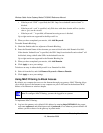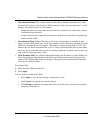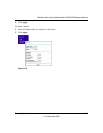
Wireless Cable Voice Gateway Model CVG824G Reference Manual
3-10 Protecting Your Network
1.0, November 2006
Port Triggering
Port Triggering is an advanced feature that allows you to dynamically open inbound ports based on
outbound traffic on different ports. This feature can be used for gaming and other Internet
applications.
Port Triggering monitors outbound traffic. When the gateway detects traffic on the specified
outbound port, it remembers the IP address of the computer that sent the data and “triggers” the
incoming port. Incoming traffic on the triggered port is then forwarded to the triggering computer.
For example, port triggering can be used for Internet Relay Chat (IRC). When you connect to an
IRC server, the server tries to connect back on the port to do an Ident lookup. Unless you have
configured Port Forwarding to open that port, the traffic will be blocked. In this example, the
initial login to the server in the range of ports is detected. This triggers the gateway to temporarily
forward the port to the PC that initiated the login.
To configure Port Triggering
1. Under Advanced on the main menu, select Port Triggering The Port Triggering screen will
display.
2. In the Trigger Range, enter the outbound ports that will be monitored for activity. This will be
the “trigger.”
3. In the Target Range, enter the inbound ports that should be forwarded when the trigger occurs.
4. Select the appropriate protocol: TCP, UDP or Both.
5. Check the Enable box
6. Click Apply.
Note: Port Forwarding is similar to port triggering, but it is static and has some
limitations. Ports are open to traffic from the Internet until the port forwarding rule
is removed. Additionally, port forwarding does not work well for some
applications when your WAN IP address is assigned by DHCP, and is changed
frequently. Port Triggering opens an incoming port temporarily and does not
require the server on the internet to track your IP address if it is changed.


















